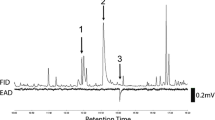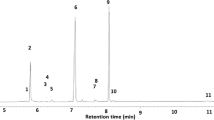Abstract
Females of the banana weevil,Cosmopolites sordidus, were attracted to and made longer visits to live conspecific males, trapped volatiles from males, and dissected male hindguts in a still-air olfactometer. Male weevils were attracted to volatiles trapped from males and made longer visits to live males and volatiles from males. Live females, collected volatiles from females and female hindguts, elicited small or no behavioral responses from either sex. Electroantennogram (EAG) responses from both male and female antennae were elicited by collected volatiles from males and by dichloromethane extracts of male hindguts and bodies but not by surface washes of males. No significant EAG responses were given to equivalent material from females. It is therefore suggested that male banana weevils release an aggregation pheromone via their hindgut.
Similar content being viewed by others
References
Blight, M.M., andWadhams, L.J. 1987. Male-produced aggregation pheromone in pea and bean weevil,Sitona lineatus (L.).J. Chem. Ecol. 13:733–739.
Booth, D.C., Phillips, T.W., Claesson, A., Silverstein, R.M., Lanier, G.N., andWest, J.R. 1983. Aggregation pheromone components of two species ofPissodes weevils (Coleoptera: Curculionidae): Isolation, identification, and field activity.J. Chem. Ecol. 9:1–12.
Borden, J. 1985. Aggregation pheromones, pp. 257–286,in G.A. Kerkit and L.I. Gilbert (eds.). Comprehensive Insect Physiology and Pharmacology, Vol. 9. Pergamon Press, Oxford.
Bowers, W.W., andBorden, J.H. 1990. Evidence for a male-produced aggregation pheromone in the four-eyed spruce bark beetle,Polygraphus rufipennis (Kirby) (Col., Scolytidae).J. Appl. Entomol. 110:292–299.
Budenberg, W.J., Ndiege, I.O., Karago, F.W., andHansson, B.S. 1993. Behavioral and electrophysiological responses of the banana weevilCosmopolites sordidus to host plant volatiles.J. Chem. Ecol. 19:267–277.
Busoli, A.C., Fernandes, O.A., andTayra, O. 1989. Controle da broca da bananeiraCosmopolites sordidus Germar 1824 (Coleoptera, Curculionidae) atraves dos fungos entomopatogenicosBeauveria bassiana (Bals.) Vuill. eMetarhizium anisopliae (Metschn.) Sorok. (Hyphomycetes)An. Soc. Entomol. Brasil 18(suppl.):33–41.
Cuille, J. 1950. Recherches sur le charançon du bananierCosmopolites sordidus, German Monographie de l'insecte et recherche de ses chimiotropismes. IFAC Servie, techn., 4, Paris. 225 pp.
Jones, M.T. 1986. Pests and diseases of bananas and plantains of Trinidad and Tobago.J. Agric. Soc. Trin. Tobago 86:18–33.
Ostmark, H.E. 1974. Economic insect pests of bananas.Annu. Rev. Entomol. 19:161–176.
Phillips, J.K., andBurkholder, W.E. 1981. Evidence for a male-produced aggregation pheromone in the rice weevil.J. Econ. Entomol. 74:539–542.
Rochat, D., Gonzalez, A.V., Mariau, D., Villanueva, A.G., andZagatti, P. 1991. Evidence for male-produced aggregation pheromone in American palm weevil,Rhynchoporus palmarum (L.) (Coleoptera: Curculionidae).J. Chem. Ecol. 17:1221–1230.
Sikora, R.A., Bafokuzara, N.D., Mbwana, A.S.S., Oloo, G.W., Uronu, B., andSeshu Reddy, K.V. 1989. Interrelationship between banana weevil, root lesion nematode and agronomic practices, and their importance for banana decline in the United Republic of Tanzania.F.A.O. Plant Prot. Bull. 37:151–157.
Treverrow, N., Bedding, R.A., Dettmann, E.B., andMaddox, C. 1991. Evaluation of entomopathogenic nematodes for the control ofCosmopolites sordidus Germar (Coleoptera: Curculionidae), a pest of bananas in Australia.Ann. Appl. Biol. 119:139–145.
Tumlinson, J.H., Hardee, D.D., Gueldner, R.C., Thompson, A.C., Hedin, P.A., andMinyard, J.P. 1969. Sex pheromones produced by male boll weevils: Isolation, identification and synthesis.Science 166:1010–1012.
Wallace, C.R. 1938. Unpoisoned baits for reducing populations of banana beetle borer (Cosmopolites sordidus).J. Aust. Inst. Agric. Sci. 4:157–160.
Waterhouse, D.F., andNorris, K.R. 1987.Cosmopolites sordidus Biological Control Pacific Prospects. Inkata Press, Melbourne, pp. 152–158.
Yaringano, C.V.M., andVan Der Meer, F. 1975. Control del “gorgonjo del platano”Cosmopolites sordidus, mediante trampas diversas y pesticidas granulados.Rev. Peru. Entomol. Agric. 18:112–116.
Author information
Authors and Affiliations
Rights and permissions
About this article
Cite this article
Budenberg, W.J., Ndiege, I.O. & Karago, F.W. Evidence for volatile male-produced pheromone in banana weevilCosmopolites sordidus . J Chem Ecol 19, 1905–1916 (1993). https://doi.org/10.1007/BF00983795
Received:
Accepted:
Issue Date:
DOI: https://doi.org/10.1007/BF00983795




